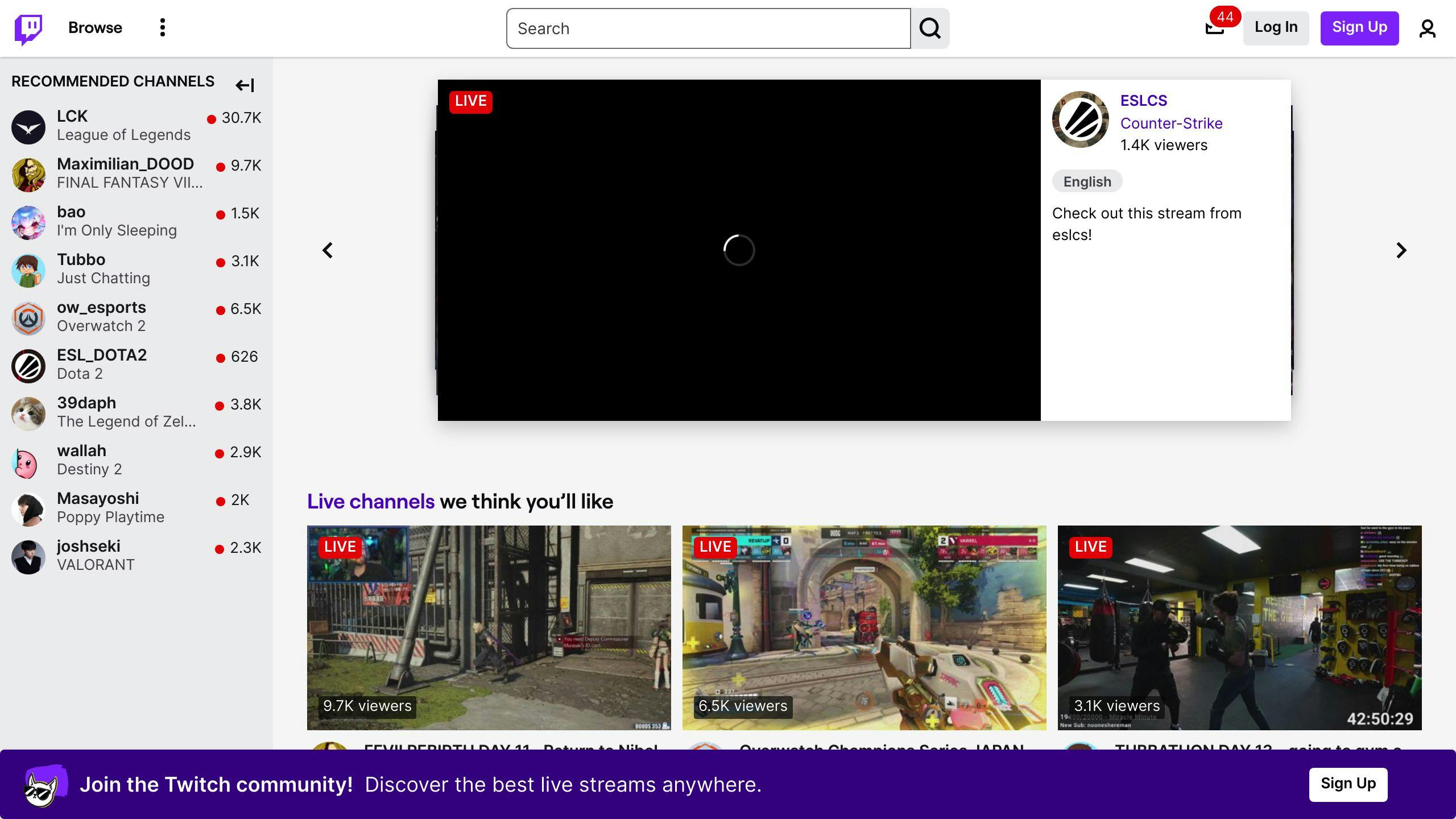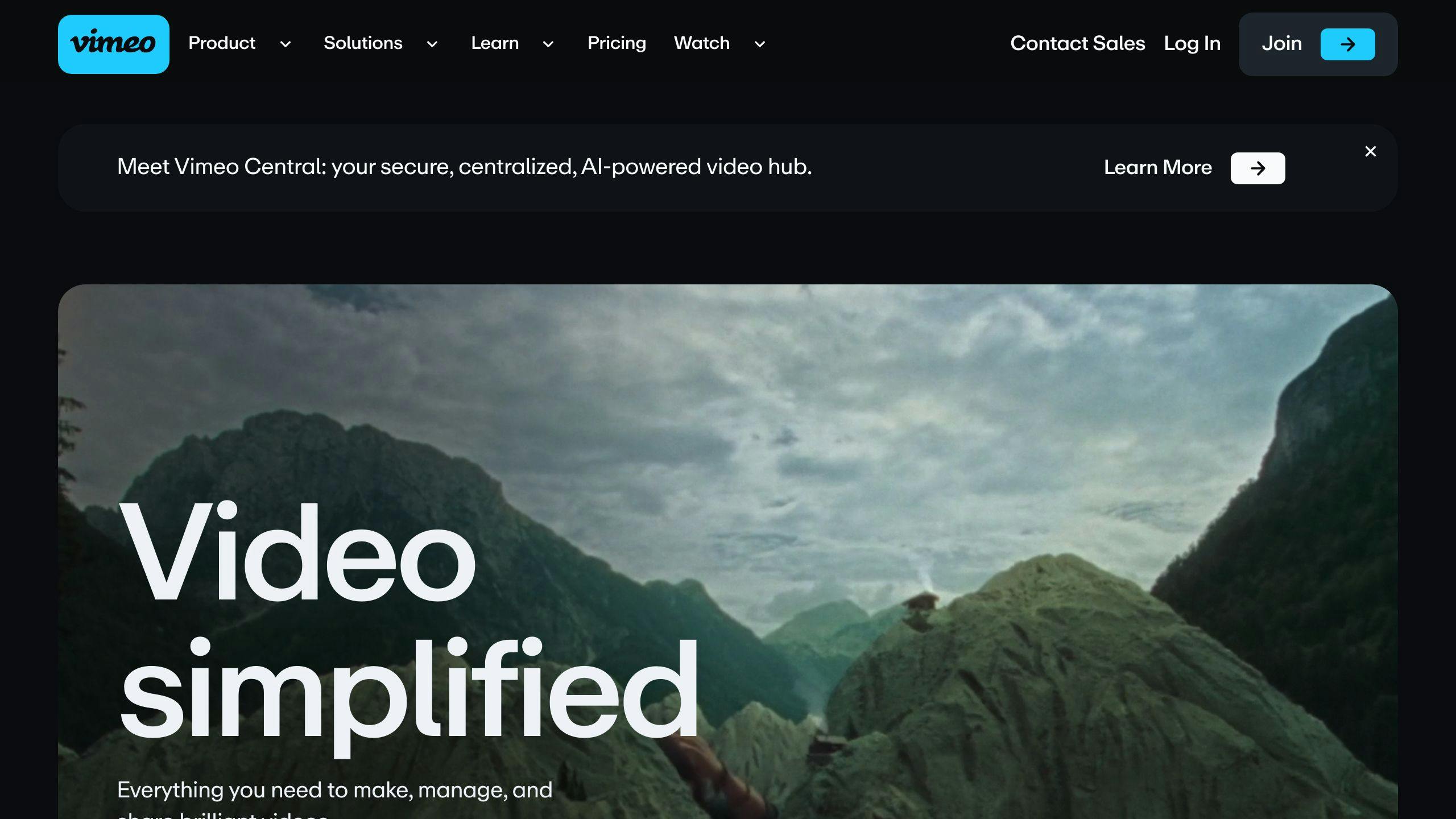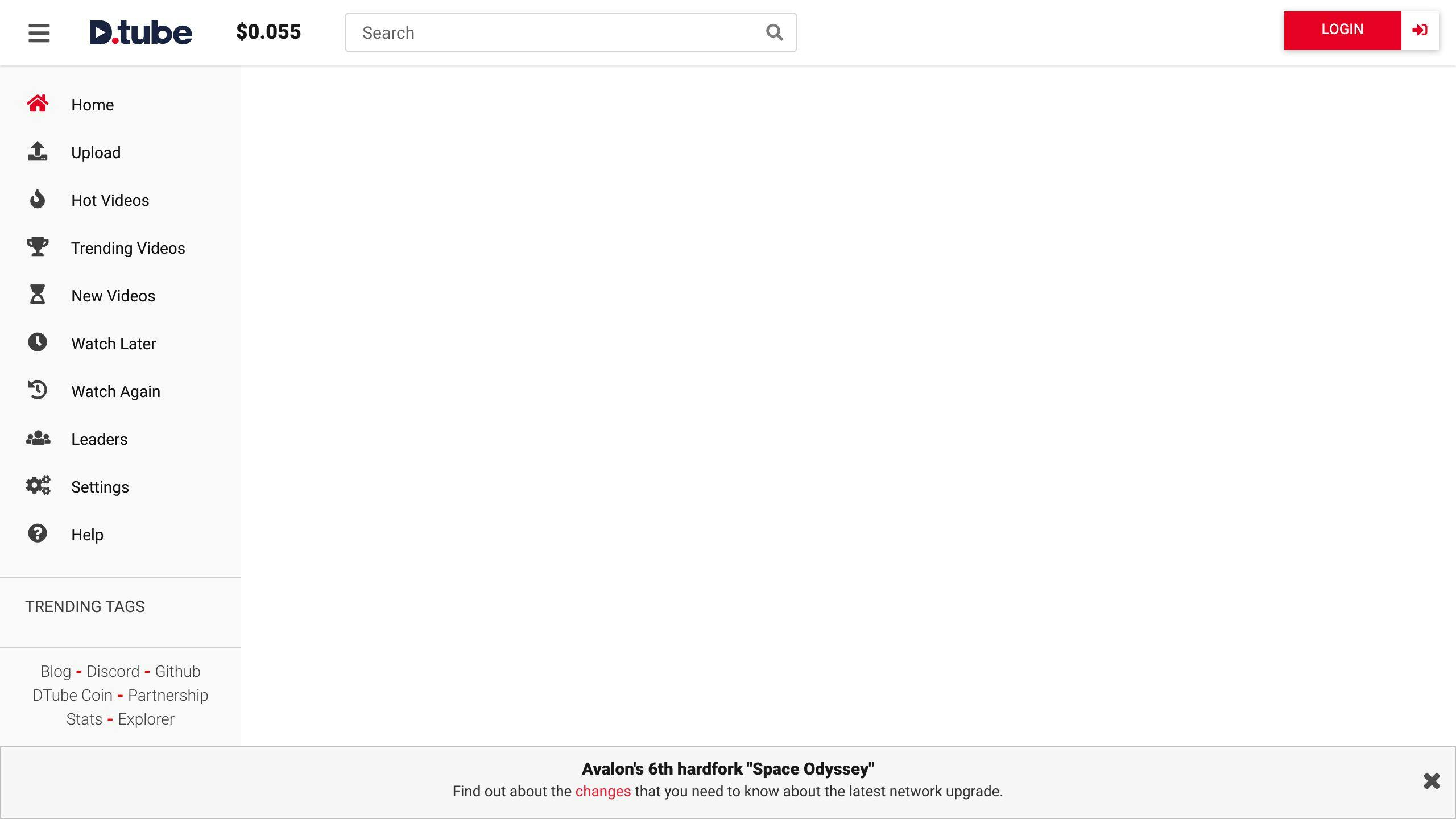Looking for alternatives to YouTube for creators? Here's a quick guide to platforms where you can monetize your content beyond YouTube in 2024:
- Patreon: Earn through subscriptions with a 5-12% platform fee.
- Twitch: Make money from subscriptions, ads, and more, with varying revenue shares.
- Vimeo: Keep 90% of your earnings through subscriptions or one-time purchases.
- Uscreen: Retain 90% of revenue, offering memberships and more.
- Facebook: Diverse monetization options without taking a cut on ad revenue.
- DTube: Earn cryptocurrency with 100% revenue share.
Quick Comparison
| Platform | Revenue Share | Monetization Models | Control Over Content | Platform Growth Potential |
|---|---|---|---|---|
| Patreon | 5-12% | Subscriptions, Tips | High | Moderate |
| Twitch | Varies | Subs, Ads, Bits | Moderate | High |
| Vimeo | 10% | On Demand, Tips | High | Moderate |
| Uscreen | 10% | Memberships, Sales | High | High |
| Free on Ads | Tips, Subs, Collabs | Moderate | Moderate to High | |
| DTube | 0% | Cryptocurrency | High | Low |
This guide offers a snapshot for creators seeking to diversify their income sources beyond YouTube, highlighting key platforms with their revenue shares, monetization models, control over content, and growth potential.
Comparison of Alternatives
Patreon
Revenue Share
Patreon keeps between 5% and 12% of the money creators make. This fee covers payment processing and gives creators access to data on how their subscribers interact with their content.
Control Over Content
Creators can decide exactly what they want to share with their Patreon subscribers. However, they can't upload videos directly to Patreon; they have to add links to videos in their posts.
Monetization Models
Patreon lets creators set up different subscription levels, so fans can pay a monthly fee for special content. Creators can also charge per piece of content, offer one-time payments, and yearly subscriptions.
Community Engagement Tools
Patreon gives creators information on what their subscribers like. But, it doesn't have as many ways to interact with fans as some other platforms that are all about videos.
Platform Growth Potential
On average, creators on Patreon make between $315 and $1,575 a month. But, growing your audience might be tough because Patreon doesn't host videos itself or help people find your content. It's more about making money from fans you already have.
2. Twitch

Revenue Share
Twitch keeps half of the money from channel subscriptions for Affiliate streamers. For Partners, how much Twitch takes is up for discussion. They also take a portion of the money made from ads, bits, and other ways to make money.
Control Over Content
Creators can decide what they want to do with their live streams and videos. But, if they break Twitch's rules, their accounts can be suspended.
Monetization Models
- Subscriptions: People can pay to subscribe to channels at different prices: $4.99, $9.99, or $24.99 a month.
- Advertising: Creators can show ads during their streams and get paid based on how many people watch.
- Bits: Viewers can buy Bits to support streamers during live shows. Streamers get $0.01 for every Bit used to cheer for them.
- Merchandise: Creators can sell things with their channel's brand on them.
Community Engagement Tools
- A live chat lets viewers talk to the creator in real time
- Polls, votes, and surveys let viewers share their opinions
- Special features like leaderboards and programs that reward loyal viewers
Platform Growth Potential
Twitch is really popular, especially with people who like video games. The top creators can make between $3,000 and $5,000 a month. But, new streamers might make less than $100 a month at first. Overall, Twitch can be a great way to make money, but it takes a lot of work and time to build a big, active group of viewers.
3. Vimeo

Revenue Share
Vimeo takes a small part, just 10%, of the money you make. This could be from people subscribing to your videos or buying them just once. You get to keep the rest, which is 90%.
Control Over Content
On Vimeo, you're in charge of your videos. You can post any video you make, as long as you follow the basic rules of the community.
Monetization Models
Vimeo lets you make money in a few ways:
- Vimeo On Demand: You can sell your videos, like special early releases or extra content, either by having people pay once to watch or through subscriptions. You set the price.
- Tip Jar: People who like your work can send you money as a tip.
- Vimeo Premium: If you join Vimeo's partner program, you can offer special content for subscribers and keep 90% of the money they pay.
Community Engagement Tools
Vimeo has a community that really cares about good videos. It offers:
- Stats on how many people watch, like, and comment on your videos
- Groups where you can meet people who like the same things
- Tools for getting feedback from others
This makes it easy to talk to your viewers and understand what they like.
Platform Growth Potential
Vimeo might not have as many people as YouTube, but its viewers really care about quality. If you focus on making great videos, you can find loyal fans and earn a steady income. Some of the best creators on Vimeo make more than $100k a year from their fans.
4. Uscreen
Revenue Share
Uscreen takes a 10% cut from what creators earn. This fee is for handling payments and giving creators data about how their subscribers behave.
Control Over Content
Creators can decide what they want to share on their Uscreen site or app. They can post special videos, courses, and even forums for their community.
Monetization Models
Uscreen lets creators make money in a few ways:
- Membership sites - Creators can ask subscribers to pay a monthly or yearly fee for access to special content.
- Membership apps - Creators can also make their own mobile and TV apps to share content. Apps help make a lot more money than just websites.
- One-off sales - Creators can sell single items, like video courses or live streams that viewers pay to watch.
- Bundles - Putting together different products, like videos and PDF workbooks, lets creators charge more.
Community Engagement Tools
Uscreen helps creators keep their community engaged:
- User profiles - Subscribers can make their own public profiles to connect with others.
- Playlists and collections - Creators can group related content together, making it easier for viewers to watch more.
- Email marketing - Creators can send newsletters to talk to their subscribers.
- Free trials and win-back campaigns - These are ways to get and keep subscribers.
Platform Growth Potential
On average, creators on Uscreen make $12,000 per month. Successful creators use strategies like:
- Driving traffic from YouTube to Uscreen for subscriptions
- Selling bundled products to make more money per subscriber
- Creating mobile apps for a better user experience and to keep subscribers longer
With Uscreen, creators have control and many ways to make money, helping them earn a steady income.
5. Facebook
Revenue Share
Facebook doesn't take a cut from ads on your videos. But, you can make money in other ways like getting tips from fans, monthly subscriptions, working with brands, and more.
Control Over Content
You decide what to post on Facebook, but you have to follow their rules. If you don't, you might lose your account.
Monetization Models
- Live Stars - People watching your live videos can send you tips. You get all of it after some small fees.
- Subscriptions - Fans can pay every month to get special stuff from you. You get 70% of this money.
- Brand Collabs - You can make deals with brands to show their stuff in your videos. How much you make can vary.
- Ad Revenue Share - If your video has ads, you get 55% of the money. Your video needs to be over 3 minutes long and watched a lot to have ads.
Community Engagement Tools
- Facebook Groups - Make or join groups to talk to people who like the same things.
- Live Video - Use live videos to chat with your viewers, ask them questions, and more.
- Insights - Check out how your videos are doing and learn about your viewers.
Platform Growth Potential
Growing on Facebook might be slower than on TikTok, but if you keep posting, you can reach more people. Some top creators make up to $50k a month, but most people make between $100 and $500 a month.
6. DTube

Revenue Share
DTube doesn't take any money from what you earn. Instead, it pays you with digital money (cryptocurrency) when people watch and interact with your videos. The more people like and watch your video, the more digital money you get.
Control Over Content
You can post whatever you want on DTube. There's no one checking or limiting what you can say or show in your videos.
Monetization Models
The main way to make money on DTube is by getting digital money (cryptocurrency) for your videos:
- You get DTube Coin (DTC) based on how many people watch and like your videos
- You can trade DTC for other digital currencies and then turn it into real money
- There's no need to have a lot of views before you can start earning
Community Engagement Tools
DTube has some simple ways to connect with viewers, like comments, voting, and following. Other ways to engage include:
- Joining or creating groups and forums that aren't controlled by any central authority
- Giving tips to creators using digital money
- Tools to see how your videos are doing and how much you're earning
The main focus is on paying creators rather than helping them build a community.
Platform Growth Potential
DTube is more for a specific group of people interested in blockchain and digital currencies. The chance to grow big here is smaller compared to more popular sites. The most successful creators might make a few hundred dollars a month, but most will likely earn just a little bit of digital money.
Key Considerations When Choosing an Alternative
When you're looking for a new place to share your videos, here's what to keep in mind:
Audience and Reach
-
Think about who you want to watch your videos. Which platforms do they use the most?
-
Size isn't everything. Sometimes, a smaller group of really interested viewers is better than a lot of people who don't care much.
-
Also, consider where you can grow your audience in the future.
Content Format Compatibility
-
What kind of videos do you make? Short clips, live streams, or something else?
-
Pick a platform that works well with your video style. For example, Twitch is great for live streaming, and TikTok is awesome for short videos.
Monetization and Revenue Share
-
Look at how you can make money - through ads, monthly payments from fans, or other ways. It's smart to have more than one way to earn.
-
See how much of the money you'll actually get to keep. Some platforms take a bigger piece of the pie than others.
-
Make sure you understand how and when you can get your money.
Level of Control, Rules and Moderation
-
Do you want to be free to create whatever you want, or are you okay with following strict rules?
-
Check out the platform's rules and what happens if you break them. Some are stricter than others.
-
Think about the risks of losing your account or dealing with copyright issues.
Analytics, Community Tools and Support
-
Can you get good info on who's watching your videos and what they like? This can help you make better content.
-
Look into how you can talk to your fans and build a community. Also, see what kind of help and support the platform offers if you run into problems.
By thinking about these things, you can figure out which platforms might work best for you. It's a good idea to try a few to see what fits your style and goals.
sbb-itb-bc761f5
Pros and Cons
Let's take a quick look at the good and bad sides of different places online where you can share your videos, other than YouTube:
| Platform | Pros | Cons |
|---|---|---|
| Patreon | - You keep most of your money from fans - You decide what to charge and share - Info on what your fans like |
- Not great for videos - You need fans already - Harder to find new fans |
| Twitch | - Big for games & live shows - Many ways to make money - Cool features to talk to fans |
- They take half of your money - Risk of losing your account - Lots of competition |
| Vimeo | - You keep most of the money - Focus on high-quality videos - Easy ways to make money |
- Not as many people watch - Harder to go viral |
| Uscreen | - You keep most of the money - You're in charge of your stuff - Good tools for membership sites |
- You need to bring in viewers - More about subscriptions, not ads |
| - Lots of people already there - Several ways to earn - You keep most of the money from fans |
- Growing your audience can be slow - Strict rules on what you can post - They keep some of the ad money |
|
| DTube | - You get all the money you make - No rules on what you can post - Paid in digital money |
- Not many people watch - Money can be unpredictable - Fewer ways to connect with viewers |
Key Takeaways
- Patreon is great for making money from people who already like your work, by offering them special stuff.
- Twitch is really good for gaming and live videos, but they take a big part of your earnings.
- Vimeo is all about quality videos and lets you keep a lot of the money you make.
- Uscreen gives you full control and is good if you have a way to bring viewers to your site.
- Facebook has a lot of viewers, but growing your fan base and dealing with rules can be tough.
- DTube gives you all the money you earn in digital currency but doesn't have a big audience or many ways to interact with fans.
Choosing the right platform depends on what you want to do, who you want to reach, and how you want to make money. Trying out a few different ones can help you spread out your income.
Conclusion
It's really important for video creators to look beyond just YouTube and think about using other websites too. This is because just using YouTube can be a bit risky. Sometimes YouTube changes how things work, which can make it harder for creators to earn money. Also, there are a lot of people trying to get noticed on YouTube, so it can be tough to stand out.
When thinking about trying other websites, here are some things creators should keep in mind:
- How money is made: How much of the money will you get to keep? What ways can you make money - like from ads, monthly support from fans, or tips?
- Who's watching and how to grow: Does the website help you connect with your viewers? How many people are using the website, and is it getting more popular?
- Rules and how you can share your videos: Are there rules about how long your videos should be or what they should be about? How strict are the website's rules?
- Understanding your success: Does the website tell you how your videos are doing? Can you get help if you're having trouble?
Creators also need to think about who they want to watch their videos and what they want to achieve by sharing their content. Some websites, like Vimeo, might have fewer people but those folks might really care about the kinds of videos you make. Facebook Watch could be a good choice if you're trying to reach a lot of people.
There's no perfect answer for everyone. The best plan is to keep using YouTube but also try out different websites to see what works best for you and your audience.
Trying new things can take some work, but it can also give creators more control and make things more stable in the long run. Finding the right mix of websites to use can really pay off.
Related Questions
What is the best alternative to YouTube to make money?
If you're looking to make money outside of YouTube, here are some good options:
- GudSho: This site lets creators make their own video websites and apps, giving them full control over their audience. Creators get to keep 85% of what they earn.
- Getshow: Similar to GudSho, it helps creators have their own space for videos. It has different ways for creators to earn money.
- Vimeo: Known for its high-quality videos and engaged viewers. Creators get to keep 90% of their earnings and have various ways to make money.
- Patreon: Great for creators who want to offer special content to their fans. It's all about getting support directly from your audience.
- DTube: This platform pays creators in digital money based on how much people watch and like their videos. There's a lot of freedom in what you can post here.
What is the alternative to monetization?
Looking for other ways to make money from your mobile app? Here are some options:
-
Meta Audience Network: This is Meta's (Facebook's) ad system that shows ads in mobile apps.
-
Amazon Publisher Services: Lets you make money through ads from Amazon in your app.
-
Smaato: A platform that helps you make as much money as possible from ads in your app.
-
Start.io: Focuses on ads that get more people to install your app.
-
InMobi: Offers ads from top advertisers and different ways to make money.
Is there a better alternative to YouTube?
In 2024, some good YouTube alternatives for streaming include:
- Hulu: Mainly for movies, TV shows, and its own original content. It has a free version with ads.
- Vimeo: Focuses on high-quality, creative videos. It has a community that cares about good content and offers ways for creators to make money.
- Twitch: Best for live streaming, especially for gaming. It has subscriptions and tips for making money.
These sites might not be as big as YouTube, but they're great for certain types of content and offer unique benefits.
Which platform is best for monetization?
Here are some of the best platforms for creators to make money:
- YouTube: Still a top choice with a huge audience. It offers ads, memberships, tips, and merch sales.
- Substack: Best for those who write newsletters. You can charge for subscriptions and keep most of the money.
- Patreon: Lets you provide exclusive content to your fans for a monthly fee. It's a direct way to get support from your audience.
- Facebook: Offers many ways to earn, including ads, stars, subscriptions, and deals with brands. It has a massive potential audience.
The best platform depends on what kind of content you make and how you want to make money. Trying out a few different ones is a good idea to see what works best for you.


